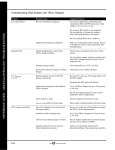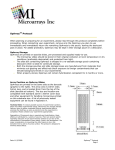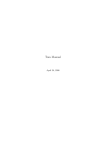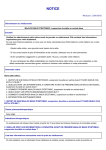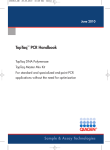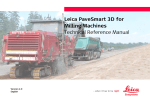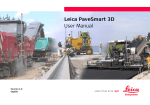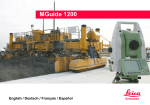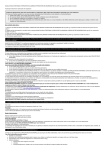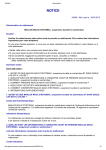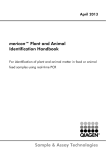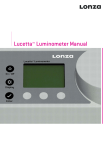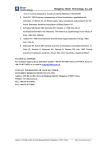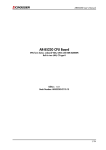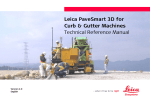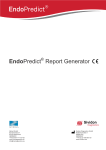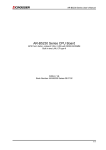Download oparray user manual
Transcript
OpArray User Manual ® Version 2.0 Notes Trademarks Patent technology and /or registered trademarks of Operon and QIAGEN: OpArrays, THE DNA COMPANY, ., OPTs. QIAquick is a trademark of QIAGEN. References These protocols are based on the following sources: OmniScript is a registered trademark of QIAGEN. 1) The MGuide – http://cmgm.stanford.edu/pbrown/mguide Registered names, trademarks, etc. used in this document, even when not specifically marked as such, are not to be considered unprotected by law. Copyright © 2001 Operon, all rights reserved 2) Eisen MB; Brown PO. DNA Arrays for Analysis of Gene Expression. Methods in Enzymology, 1999, 303:179-205. 3) DeRisi Lab Protocols – http://www.microarrays.org Operon Technologies, Inc. 1000 Atlantic Ave., Alameda, CA 94501, USA Ph: 800-688-2248 Email: [email protected] 510-865-8644 Web: www.operon.com Operon GmbH Nattermannallee 1, D-50829 Köln, Germany Customer Service: 00800-OP ORDERS (00800-67 67 33 77) Tech Support: 00800-OP SUPPORT (00800-677 877 678) Email: [email protected] 2 Web: www.operon.com OpArray® User Manual OpArray® User Manual 15 Table of Contents VIII. Troubleshooting Problem Probable Causes Solution Lov yield cDNA probe Source RNA degraded Run RNA on an agarose gel to insure RNA integrity Reagents not RNase free Run cDNA out on a gel +/- RNA impure Check RNA purification procedure for errors. Repurify RNA Nucleotides degraded Inefficient dye incorporation I. Product Description 4 II. Kit Contents 5 III. Reagents and Equipment Needed 6 Make frozen aliquots of nucleotides IV. Handling and Storage Conditions 7 Missing reagent Check reaction and repeat V. Reverse Transcription/Labeling Protocol 7 Inactive reverse transcriptase Retr y reaction with fresh enzyme VI. Hybridization Protocol 12 Failure to neutralize cDNA prior to QIAquick purification Add sodium acetate to sample following treatment with hydroxyalamine VII. Post Treatment 13 Cy Dye pack inactive Store dried Cy aliquots from DMSO in the absence of light at 4°C in a desiccator VIII. Troubleshooting 14 pH of Carbonate buffer not equal to 8.5-9.0 Test pH of 100mM carbonate buffer Poor probe quality Take a spectrophotometer reading of the probe prior to hybridization. See low yield cDNA probe/inefficient dye incorporation Insufficient blocking of the slide Insufficient washing following hybridization can result in spots containing "comet tails," or smear y spots. This can be avoided by thoroughly dunking slides during these washes High slide background Poor probe quality Ver y low spot intensities Scanning intensity too low 14 Take a spectrophotometer reading of the probe prior to hybridization. See low yield cDNA probe/inefficient dye incorporation Increase scanning power OpArray® User Manual OpArray® User Manual 3 I. Product Description In the past few years, as genome project sequencing information has become widely available, the popularity and usefulness of DNA microarrays has grown exponentially. One widely used application for these “gene chips” has been the monitoring of gene expression. In response to the demand for a reliable tool for this purpose, Operon has developed the OpArray, a microarray containing optimized long oligonucleotide sequences. Genes with a high degree of homology can present cross hybridization problems that lead to false negatives and positives. Currently available genomic primer sets provide oligos that are used in the amplification of DNA products, spanning the full open reading frame (ORF) from start to stop codon. In contrast, Operon designs and synthesizes oligos representing a 70nt region of the gene of interest. These sequence o p t i m i z e d 7 0 m e r s , o r O P Ts , a r e bioinformatically designed to minimize cross hybridization. In addition, sequences are Tm normalized and selected to minimize secondary structure. Slide A Slide B Figure 2: Applying the Probe • Lifter slips make pipetting the probe very easy. It wicks under the cover slip with no bubbles (slide B) Note: New cover slips are longer and should be placed on the slide 90° to the one shown in the picture above. • • • Place the slide into the hybridization chamber Pipette 15µl 3 x SSC near one of the edges of the slide, away from the cover slip Tighten the screws for the chamber cover and place the assembly in a 67ºC water bath for 6-12 hrs. VII. Post Treatment Wash 1: 1 x SSC, 0.03% SDS Wash 2: 0.2 x SSC Wash 3: 0.05 x SSC • Carefully remove the chamber and dry it with paper towels Note: If you have several chambers to process, dry them off and remove the screws, but refrain from cracking them open until all the chambers are ready to open. • • Remove the slide from the chamber and place it into a slide rack to be washed Gently plunge the rack up and down several times to get the cover slip to fall off the slide. Wash for 2-3 min. Note: Lifter cover slips are reusable and should be washed in 70% EtOH prior to use. • Always spin-dry the slides for 5 min. Note: If using 50ml conical tubes to spin slides with the table top centrifuge, be sure that the slide is orientated with the label side down. 4 OpArray® User Manual OpArray® User Manual 13 VI. Hybridization Protocol II. Kit Contents A. Probe Preparation Note: The probe can be dried down to an appropriate volume. Add SDS last, just prior to denaturation, to avoid precipitation. Use 12-15µl probe mix per hybridization. If using Lifter slips, prepare 20µl of probe per hybridization. Stock Final [ ] µl 20X SSC 2.6X 1.9 *Poly dA/Cot1 (10µg/µl) 10µg 1 cDNA probe mix ~1µg 10.6 2%SDS 0.2% 1.5 All OpArrays are shipped with the following materials: • OpArray reference slide • Floppy disk containing the following files: – array layout *Include Cot 1 DNA for Human Probe only – gene list – OpArray QC hybridization images – Readme.txt - array parameters • Denature at 95ºC for 2 min. • Spin probe briefly Note: This serves two purposes: 1) to pellet condensation 2) to cool probe B. Applying Probe • Align hybridization slide with reference slide Note: Spots can be visualized by breathing on the slide to fog the surface. • Place clean lifter cover slip, Teflon side down, over the array area Note: Lifter cover slips have Teflon edges along the two opposing outer edges. This provides an advantage over traditional cover slips in that it allows for better diffusion of probe. In addition, air bubbles under the slip are more easily avoided. • Place pipette tip along an open edge of the cover slip and slowly pipette the probe out of the tip. Capillary action will draw the probe mix under the slip • Please note the hydration spot near the left side of slide A (added last, just prior to loading the chamber). See figure 2 12 OpArray® User Manual OpArray® User Manual 5 III. Reagents and Equipment Needed QC Probe The quality of the probe may be checked by scanning it in a spectrophotometer (200-700nm). Description Supplier Catalog # Price OmniScript® (200 units) QIAGEN 205111 $155.00 5-(3-aminoallyl)-2'-deoxyuridine 5' triphosphate Sigma A0410 5mg for $277.40 Cy3 Mono-Reactive dye pack Amersham PA23001 $170.00 Cy5 Mono-Reactive dye pack Amersham PA25001 Microcon YM-30 (24) Millipore QIAquick PCR Purification Kit (50) Peak Sample 260nm cDNA $170.00 550nm Cy3 42409 $64.00 649nm Cy5 QIAGEN 28104 $68.00 Poly dA (18mer) Operon Technologies Custom Synthesis Get Quote Human Cot1 DNA Several N/A N/A Hybridization Chamber Operon Technologies Get Quote Get Quote Hydroxylamine Sigma H2391 $22.60/100g 20X SSC Sigma S-6639 $36.30/liter SDS Several N/A N/A Slide Rack Several N/A N/A Slide Chamber Several N/A N/A Slide Scanner Several N/A N/A Analysis Software Several N/A N/A Figure 1: Sample Spectrophotometer Reading prices subject to change May 2001 Note: i) If performing the QC scan, it is essential that all unconjugated dye is removed from the sample. The QIAGEN PCR Purification Kit is sufficient for this. If another kit is used for the last cleanup step, insure that dye removal is sufficient so the QC scan doesn’t detect dye carry over. ii) For dye conjugation, DMSO does not interfere with the conjugation reaction. Hence it is not necessary to dry down the dye aliquots if they are to be used directly. Simply re-suspend the cDNA in Carbonate buffer and add the dye in DMSO directly. 6 OpArray® User Manual OpArray® User Manual 11 Protocol for QIAGEN PCR Purification Kit: IV. • Add 35µl 100 mM NaOAc, pH 5.2 to each reaction • Combine reactions in 1 tube • Add 500µl PB Buffer • Apply sample to QIAquick column • Spin for 30-60 sec., ~13,000 RPM (>10,000 x g) • Discard flow-through, add 750µl PE buffer • Spin for 30-60 sec. • Discard flow-through • Spin for 1 min. • Place column in new tube • Add 50µl EB Buffer or H2O to membrane Slides should be handled with gloves to avoid smudges and dirt. Store slides desiccated at 4°C in the absence of light. Store oligo aliquots at -20°C. V. Reverse Transcription/ Labeling Protocol This protocol utilizes Mono-Reactive Cyanine dyes to label cDNA after reverse transcription. Incorporation of a nucleotide containing an alkyl amino group allows post RT conjugation. Although there are other labeling methods available, we have found this protocol to be simple and effective. Aliquotting: 50X dNTP Mix Note: Eluted volume is typically around 48µl. You may choose to elute with 1/2 x EB buffer and reduce the volume for hybridization in the spin vac. • Handling and Storage Conditions dNTP 1x 50x Stock [] Volume dATP 500 µM 25mM 100mM 10µl dCTP 500 µM 25mM 100mM 10µl dGTP 500 µM 25mM 100mM 10µl dTTP 300µM 15mM 100mM 6µl aa-dUTP 200µM 10mM 100mM 4µl Spin for 1 min. Dye Packs • • • • 10 OpArray® User Manual Resuspend Cy dyes in 72 µl DMSO Aliquot 4.5 µl to 16 tubes Lyophilize in Speed Vac Store sample in the absence of light at 4°C in a desiccator OpArray® User Manual 7 C. Reaction Cleanup A. Reverse Transcription Reaction Note: 2µg of mRNA should make enough probe for 2-3 hybridizations. RNA mix [ ] µl Oligo dT 5mg/ml 1 mRNA 1 to 2µg 14.5 • • • Incubate at 70°C for 10 min. Chill on ice Add the following reagents to the tube Stock [] µl 10X Buffer 10X 3 aa-dUTP/dNTPs 50x 0.6 OmniScript 1.9 Water 9 • 8 Place 450µl H2O in Microcon 30 Add reaction mix Spin at 11,000 x g for 12 min. Remove flow-through Repeat wash 2 x with H2O Invert microcon in a new tube and elute by spinning 11,000 x g for 20 sec. The volume may range from 4µl to 40µl • Dry down in spin vac and store at –20°C D. Coupling of Cy Dye • • • • Resuspend cDNA in 4.5µl of H2O Resuspend aliquot of Cy dye in 4.5µl 0.1 M Carbonate buffer, pH 8.5-9.0 (use Bicarbonate to adjust the pH) Mix cDNA and Cy dye Incubate in the dark for 1 hr. at room temperature E. Quench Reaction • • • Incubate at 37°C for 2 hrs. B. Hydrolysis of RNA • • • • • • • • • • Quench any un-reacted Cy dye by adding primary amines Add 4.5µl 4M Hydroxylamine Incubate for 15 min. in the dark at room temperature F. Reaction Cleanup II and Hyb Prep Mix 10µl 1N NaOH and 10µl 0.5M EDTA Add to RT reaction Incubate for 15 min. at 65°C Neutralize 25µl 1M Tris ph 7.4, or 25µl 1M HEPES pH 7.0 OpArray® User Manual • Cy3 and Cy5 reactions can be combined and cleaned up together or separately. Removal of free dye can be performed with either gel filtration via spin column or Pasteur pipette, or with various kits, such as QIAGEN PCR Purification Kit. The QIAGEN PCR Purification Kit works well for this step. However, it is important to keep in mind that the DNA binding curve for silica, on which this kit is based, is favorable at low pH but falls off precipitously around pH 8. Thus it is essential that the pH of the reaction is below 7.5 before it attaches to the QIAGEN membrane. OpArray® User Manual 9









